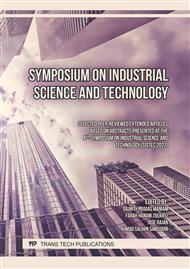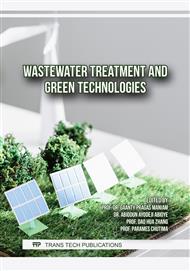[1]
PLN, Statistik PLN 2021 (Unaudited), PT PLN (Persero), Jakarta, 2022.
DOI: 10.15676/ijeei.2021.13.3.6
Google Scholar
[2]
E. Hilmawan, I. Fitriana, A. Sugiyono, Adiarso (Eds.), Outlook Energi Indonesia 2021, BPPT, Jakarta, 2021.
Google Scholar
[3]
Bappenas, Indonesia Long-Term Strategy for Low Carbon and Climate Resilience 2050, Jakarta, 2021.
Google Scholar
[4]
KESDM, Laporan dari ETWG: Program De Dieselisasi untuk Energi Bersih, News Archives https://www.esdm.go.id/en/media-center/news-archives/dukung-program-dedieselisasi-menteri-esdm-teknologi-dan-biaya-kompetitif-jadi-kunci-keberhasilan, access 07 September 2022.
Google Scholar
[5]
PLN, Rencana Usaha Penyediaan Tenaga Listrik (RUPTL) PT PLN (Persero) 2021-2030, Jakarta, 2021.
Google Scholar
[6]
Ditjen Gatrik, Evaluasi Penyediaan dan Pemanfaatan Tenaga Listrik Tahun 2021, Rapat Koordinasi Pengawasan Pencapaian Bauran Energi Nasional Semester I Tahun 2022, Dewan Energi Nasional, Bandung, 2022.
DOI: 10.17146/jpen.2021.23.1.6161
Google Scholar
[7]
D. Syafrianto, K. M. Banjar-Nahor, H. Nugraha, D. F. Hakam, P. O. Hadi and N. Hariyanto, Optimized Hybrid Power System Configuration for The First Phase of Dedieselization Programs, 2021 3rd International Conference on High Voltage Engineering and Power Systems (ICHVEPS), 2021, pp.387-392.
DOI: 10.1109/ichveps53178.2021.9601010
Google Scholar
[8]
IEA, Projected Costs of Generating Electricity 2015, OECD Publishing, Paris, https://doi.org/10.1787/cost_electricity-2015-en, 2015.
DOI: 10.1787/cost_electricity-2015-en
Google Scholar
[9]
J.A. Ordonez, M. Fritz, J. Eckstein, Coal vs. renewables: Least-cost optimization of the Indonesian power sector, Energy for Sustainable Development 68 (2022) 350–363.
DOI: 10.1016/j.esd.2022.04.017
Google Scholar
[10]
C.A. Putri, Pajak Karbon Batal Berlaku 1 Juli: Sri Mulyani Buka Suara, CNBC Indonesia, 27 Juni 2022.
Google Scholar
[11]
M.C. Anwar, Mengenal Apa Itu Pajak Karbon yang Mulai Berlaku 1 Juli 2022, Kompas.com, 2 April 2022.
Google Scholar
[12]
Ditjen EBTKE, Statistik EBTKE 2016, Kementerian Energi dan Sumber Data Alam, Jakarta, 2016.
Google Scholar
[13]
Ditjen EBTKE, Potensi Energi Terbarukan di Indonesia per Provinsi, Kementerian Energi dan Sumber Data Alam, Jakarta, 2022.
DOI: 10.21831/jnp.v7i2.21901
Google Scholar
[14]
Ditjen Gatrik, Statistik Ketenagalistrikan 2020, Kementerian Energi dan Sumber Data Alam, Jakarta, 2021.
Google Scholar
[15]
MEMR, Handbook of Energy & Economic Statistics of Indonesia 2021, Ministry of Energy and Mineral Resources, Jakarta, 2022.
Google Scholar
[16]
Kementerian Keuangan, APBN Kita: Kinerja dan Fakta Kaleidoskop 2021, Jakarta, 2022.
Google Scholar
[17]
ACE, Levelised Costs of Electricity (LCOE) for Selected Renewable Energy Technologies in the ASEAN Member States II, ASEAN Centre for Energy, Jakarta, 2019.
Google Scholar
[18]
A. Umah, PLN Konversi PLTD ke PLTS di 200 Lokasi, Butuh Duit Rp 100 T!, CNBC Indonesia, 2 November 2020.
Google Scholar
[19]
IRENA, Renewable Power Generation Costs in 2020, International Renewable Energy Agency, Abu Dhabi, 2021.
Google Scholar
[20]
IEA, Projected Costs of Generating Electricity 2020: 2020 Edition, International Energy Agency, 2020.
DOI: 10.1787/a6002f3b-en
Google Scholar
[21]
D. Christian, Menteri ESDM: Program Dedieselisasi PLN Kunci RI Capai Net Zero Emission pada 2060, Press Release No. 148.PR/STH.00.01/III/2022, PLN, 23 Maret 2022.
Google Scholar
[22]
I. A. C. Nirmala dan A. Sugiyono, Prospek Pengembangan Pembangkit Listrik Tenaga Bayu di Indonesia: Analisis Berdasarkan Biaya Pokok Penyediaan Pembangkitan, Prosiding Seminar Nasional Teknologi Bahan dan Barang Teknik, hal. 63-68, 2020.
DOI: 10.37209/jtbbt.v10i1.170
Google Scholar
[23]
Danish Energy Agency, Technology Data for the Indonesian Power Sector, 2021.
Google Scholar
[24]
R.E.P. Dewi dan E. Rosmalasari, Dampak Ekonomi dari Pemanfaatam Kendaraan Bermotor Listrik Berbasis Baterai, dalam Bunga Rampai Penguatan Ekonomi Berkelanjutan melalui Penerapan Kendaraan Berbasis Listrik, BPPT, 2020.
DOI: 10.31544/jtera.v7.i1.2022.65-72
Google Scholar



